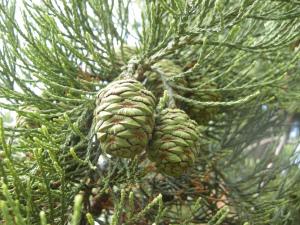
Sequoiadendron giganteum juvenile cones (16/08/2011, Cambridge)
Position: Full sun to partial shade
Soil: Deep well drained sandy loam
Flowering period: Spring
Eventual Height: 80m
Eventual Spread: 10m
Hardiness: USDA Zone 6a-8b
Family: Cupressaceae
Sequoiadendron giganteum is a fast growing evergree, coniferous tree with an uptight, cone shaped habit. Its leaves are awl-shaped and arranged spirally on the shoots. Its monoecious flowers are wind pollinated, taking the form of cones which take 18-20 months to mature. It has distinctive red coloured fibrous bark which is deeply furrowed and can be up to 90cm thick at the base of a mature tree.
S. giganteum , commonly known as the Giant Sequoia, Sierra Redwood or Wellingtonia, is native to the western slopes of Sierra Nevada in the USA. This tree is the only living tree in its genus and is one of three trees know as Redwoods, the other two being Sequoia sempervirens (Cost Redwod) and Metasequoia glyptostroboides (Dawn Redwood). S. giganteum is the worlds largest tree in terms of total volume.
S. giganteum was first named Wellingtonia gigantea in 1853 by John Lindley, this had to be changed as the genus Wellingtonia had already been used for an unrelated plant. In 1854 it was renamed to Sequoia gigantia by Joseph Decaisne. Once again this name was invalid. In 1907 Carl Ernst Otto Kuntze place this tree in the fossil genus Steinhauera. However doubts as to whether this tree was related to this genus made this name invalid. It was finally given its current nomenclatural name in 1939 by J. Buchholz.
Sequoiadendron is derived from Sequoia meaning ‘Big Tree’ from the famous Native American Cherokee tribe and dendron being Latin for trre. Giganteum is derived from the Latin meaning large or gigantic.

Sequoiadendron giganteum (16/08/2011, Cambridge)
This plant may be useful to the landscape architect as a large, maintenance free evergreen conifer specimen tree. This tree will not tolerate maritime exposure
The Royal Horticultural Society gave this plant their prestigious Award of Garden Merit in 1993.
This plant will tolerate most soil conditions; it will be happy at neutral to acid pH levels, in loam. It prefers a sandy soil although loamy or clay soils are both acceptable.
Ecologically this plant may attract various species of birds which will perch on its branches and shelter in its foliage.
Maintenance: This plant requires no maintenance. Dead or damaged material may be removed in winter.

